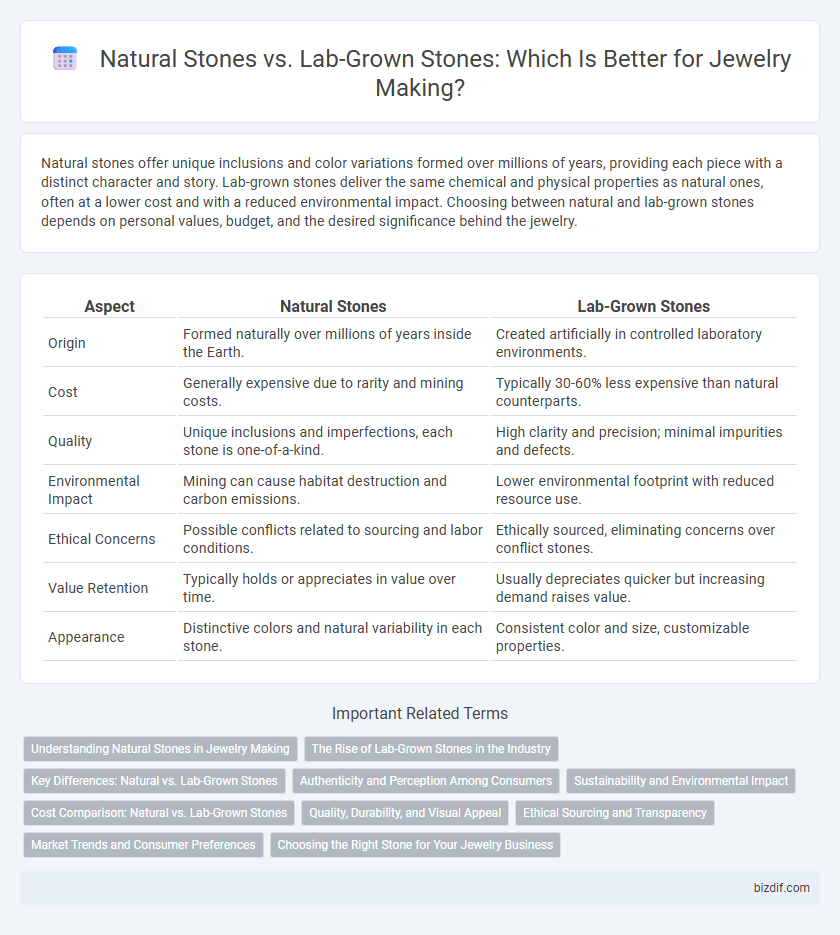Natural stones offer unique inclusions and color variations formed over millions of years, providing each piece with a distinct character and story. Lab-grown stones deliver the same chemical and physical properties as natural ones, often at a lower cost and with a reduced environmental impact. Choosing between natural and lab-grown stones depends on personal values, budget, and the desired significance behind the jewelry.
Table of Comparison
| Aspect | Natural Stones | Lab-Grown Stones |
|---|---|---|
| Origin | Formed naturally over millions of years inside the Earth. | Created artificially in controlled laboratory environments. |
| Cost | Generally expensive due to rarity and mining costs. | Typically 30-60% less expensive than natural counterparts. |
| Quality | Unique inclusions and imperfections, each stone is one-of-a-kind. | High clarity and precision; minimal impurities and defects. |
| Environmental Impact | Mining can cause habitat destruction and carbon emissions. | Lower environmental footprint with reduced resource use. |
| Ethical Concerns | Possible conflicts related to sourcing and labor conditions. | Ethically sourced, eliminating concerns over conflict stones. |
| Value Retention | Typically holds or appreciates in value over time. | Usually depreciates quicker but increasing demand raises value. |
| Appearance | Distinctive colors and natural variability in each stone. | Consistent color and size, customizable properties. |
Understanding Natural Stones in Jewelry Making
Natural stones in jewelry making are prized for their unique mineral compositions, inherent imperfections, and geological history, which contribute to each piece's distinct character and value. These gems undergo natural formation processes over millions of years, developing variations in color, clarity, and texture that cannot be replicated by synthetic methods. Understanding factors such as origin, rarity, and treatment is essential for jewelers to authenticate and appraise natural stones accurately.
The Rise of Lab-Grown Stones in the Industry
Lab-grown stones have surged in popularity within the jewelry-making industry due to their ethical sourcing and cost-effectiveness compared to natural stones. Advanced technology enables the creation of chemically and visually identical gems, attracting environmentally conscious consumers. This shift influences market demand, leading to increased integration of lab-grown stones in fine jewelry collections.
Key Differences: Natural vs. Lab-Grown Stones
Natural stones are formed over millions of years through geological processes, resulting in unique imperfections and variations that appeal to collectors and connoisseurs. Lab-grown stones, created using advanced technological methods like chemical vapor deposition or hydrothermal synthesis, offer a more affordable and environmentally friendly alternative with consistent clarity and color. While natural stones often hold higher market value and rarity, lab-grown stones provide ethical sourcing and traceability without compromising on the optical and chemical properties.
Authenticity and Perception Among Consumers
Natural stones, formed over millions of years through geological processes, are prized for their unique inclusions and rarity, which enhance their perceived authenticity and value among consumers. Lab-grown stones, chemically and physically identical to natural gems, offer ethical and cost-effective alternatives but often face skepticism regarding their authenticity and emotional significance. Consumer perception tends to favor natural stones for heirloom-quality jewelry, while lab-grown stones appeal to environmentally conscious buyers seeking sustainable luxury.
Sustainability and Environmental Impact
Natural stones often involve extensive mining processes that can lead to habitat destruction, soil erosion, and water pollution, raising significant environmental concerns. Lab-grown stones require less energy and water, generate fewer emissions, and reduce the depletion of finite natural resources, making them a more sustainable choice in jewelry making. Selecting lab-grown stones helps minimize ecological footprint while maintaining the beauty and quality of precious gems.
Cost Comparison: Natural vs. Lab-Grown Stones
Natural stones generally command higher prices due to their rarity, unique inclusions, and the extensive mining process required to obtain them. Lab-grown stones offer a more cost-effective alternative as they can be produced in controlled environments, reducing extraction and transportation costs significantly. Consumers often find lab-grown gems provide the same visual appeal and chemical properties as natural stones but at a fraction of the price.
Quality, Durability, and Visual Appeal
Natural stones exhibit unique inclusions and color variations that enhance their authentic charm, while lab-grown stones offer nearly flawless clarity and consistent coloration, appealing to those seeking perfection. Both natural and lab-grown stones possess comparable durability, with hardness levels measured on the Mohs scale, ensuring longevity in jewelry pieces. Visual appeal varies by preference; natural stones captivate with their distinct, one-of-a-kind patterns, whereas lab-grown stones provide vibrant, vivid colors and often greater brilliance due to controlled growth conditions.
Ethical Sourcing and Transparency
Natural stones are valued for their unique characteristics but often raise concerns regarding ethical sourcing, including environmental impact and labor conditions in mining regions. Lab-grown stones offer greater transparency, as their production involves controlled environments with documented ethical practices and minimal ecological footprint. Choosing lab-grown stones can ensure responsible sourcing while maintaining the same visual and physical properties as natural counterparts.
Market Trends and Consumer Preferences
Natural stones continue to dominate the luxury jewelry market due to their unique inclusions and perceived authenticity, driving higher demand among collectors and traditional consumers. Lab-grown stones, valued for their ethical sourcing and affordability, are rapidly gaining market share, especially among environmentally conscious and millennial buyers. Recent industry reports indicate a growing trend toward hybrid collections that blend natural and synthetic elements to cater to diverse consumer preferences and sustainability goals.
Choosing the Right Stone for Your Jewelry Business
Natural stones offer unique inclusions and color variations that appeal to customers seeking authenticity and rarity in jewelry, often commanding higher prices due to their natural origin. Lab-grown stones provide consistent quality, affordability, and ethical sourcing, making them ideal for businesses prioritizing sustainability and cost-effective production. Selecting the right stone depends on your target market's preferences, budget constraints, and brand values surrounding authenticity and environmental impact.
Natural Stones vs Lab-Grown Stones Infographic

 bizdif.com
bizdif.com